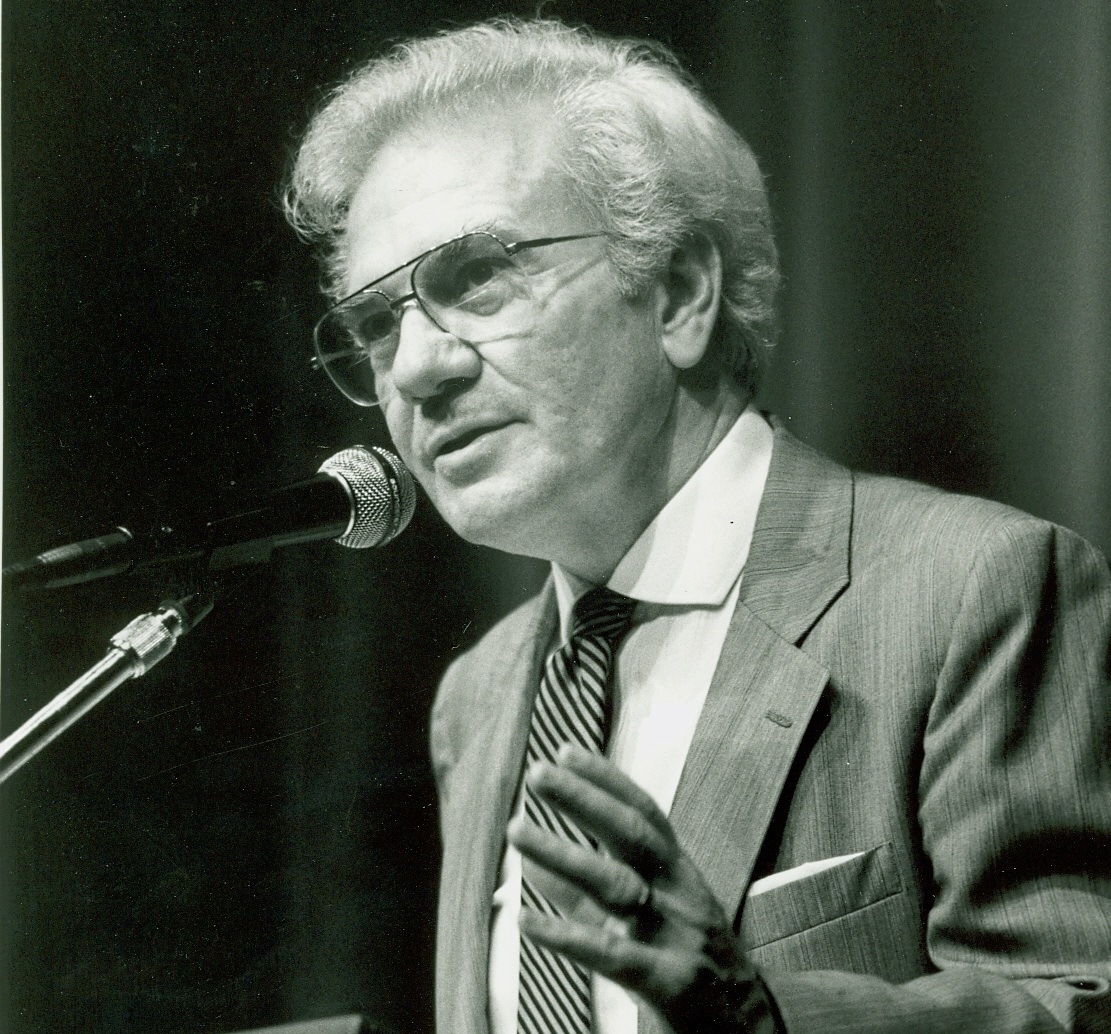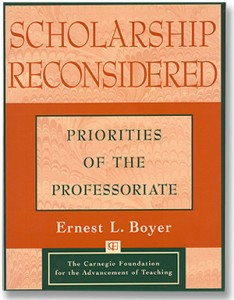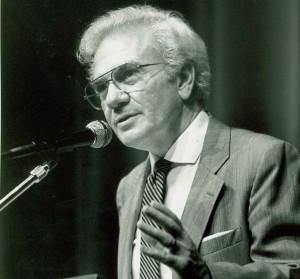
Ernest L. Boyer speaking at a conference on quality teaching in higher education at Drexel University in Philadelphia, Pennsylvania, in 1987. (Boyer Center Archives, BCA)
Dr. Ernest L. Boyer Sr., was an American educational pioneer and innovator in secondary and postsecondary education.
Boyer was born in 1928 in Dayton, Ohio, to Clarence and Ethel Boyer; his father was a minister in the Brethren in Christ Church. The young Boyer attended Messiah Academy (later Messiah College), where he met and married his wife, Kathryn (Kay) Garis Tyson. After two years at Messiah, Boyer transferred to Greenville College in Illinois, where he completed his undergraduate degree in 1950. (At Greenville, Boyer was roommates with D. Ray Hostetter, future president of Messiah and Boyer’s colleague during his later years as a member of the Messiah College Board of Trustees.)
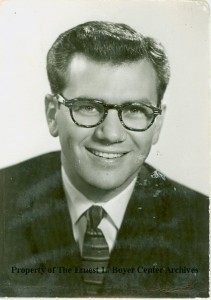
Photo of Boyer most likely taken during his time as academic dean at Upland College in California (BCA)
After graduation, Boyer served for two years as pastor of a Brethren in Christ congregation in Florida. In 1951 the Boyers moved to Upland, California, where Boyer assumed a faculty position at Upland College, a small liberal arts school owned and operated by the Brethren in Christ Church. He would later serve as the school’s academic dean. He also began work on a master’s degree in speech pathology and audiology at the University of California Santa Barbara, which he completed in 1955. He earned his doctorate two years later, in 1957. During this same time he also taught at Loyola University.
In 1960, Boyer made a permanent move from teaching to administration and leadership when he assumed a position with the Western Colleges Association as director of the Commission to Improve the Education of Teachers. In 1962 he accepted a new role as director of the Center for Coordinated Education at his alma mater, the University of California, Santa Barbara; in this capacity Boyer administered projects aimed at improving California’s education system.
In 1965, Boyer and his family moved across the country to Albany, New York, where Boyer joined the State University of New York (SUNY) system as its first executive dean. In 1968 he became SUNY’s vice president; in 1970 he assumed the role of SUNY’s chancellor, in which role he worked to unify the 62 colleges in the SUNY system, calling for cooperation and community, two of his work’s lasting themes. Moreover, according to the Gale Encylcopedia of Education,
One of [Boyer’s] most significant accomplishments as chancellor was the creation of the Empire State College in Saratoga Springs, New York. This college allows adult students to earn degrees without attending classes on campus. The students earn degrees via workshops, reading, television, and hands-on experience.
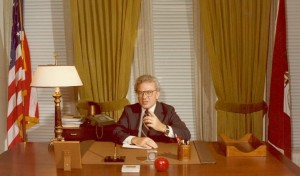
Ernest L. Boyer sitting at his desk at his welcoming party to Washington, DC as the new Commissioner of Education, 1977 (BCA)
Boyer remained at SUNY until 1977, when President Jimmy Carter called him to serve as the U.S. Commissioner of Education, a post he held until 1979. In this role, Boyer prioritized reform of secondary education in America. He initiated a nationwide service-learning program whereby students could earn credit by participating in hands-on experiences in their communities. He also developed a concern for Native American education, and worked to improve the Native American school system.
Boyer would later observe that his goal as U.S. Commissioner of Education was to bridge the education gap in America, creating a pathway to improvement for those disadvantaged by economic disparity and privilege. His concern for those on the margins of American society would also become a hallmark of his later work.
Toward the end of his time in Washington, D.C., Boyer accepted a new role as president of the Carnegie Foundation for the Advancement of Teaching. Boyer moved the Foundation’s headquarters to Princeton, New Jersey, while maintaining an office in D.C. from which to work at public policy reforms related to education. From these two headquarters Boyer expanded the work of the Foundation to focus on public education, creating what he called “dialogues” concerning education issues. Boyer continued to work for the Foundation, giving numerous public lectures and speeches, until his untimely death on December 8, 1995. He was 67 years old.
Throughout his career, Boyer published numerous landmark studies, including High School: A Report on Secondary Education in America (New York: Harper & Row, 1983); College: The Undergraduate Experience in America (New York: Harper & Row, 1987); Campus Life: In Search of Community — A Special Report (Princeton: The Carnegie Foundation for the Advancement of Teaching, 1990); Scholarship Reconsidered (Princeton: The Carnegie Foundation for the Advancement of Teaching, 1990); Ready to Learn (Princeton: The Carnegie Foundation for the Advancement of Teaching, 1991); School Choice (Princeton: The Carnegie Foundation for the Advancement of Teaching, 1992); and The Basic School: A Community for Learning (Princeton: The Carnegie Foundation for the Advancement of Teaching, 1995).
In 1997, two years after Boyer’s death, Messiah College established the Ernest L. Boyer Center, which seeks to foster the enrichment of students and teachers through implementation of Boyer’s educational vision. The center’s mandate includes preserving and providing access to Boyer’s papers, which include speeches, manuscripts, photographs, memorabilia, and other material.
